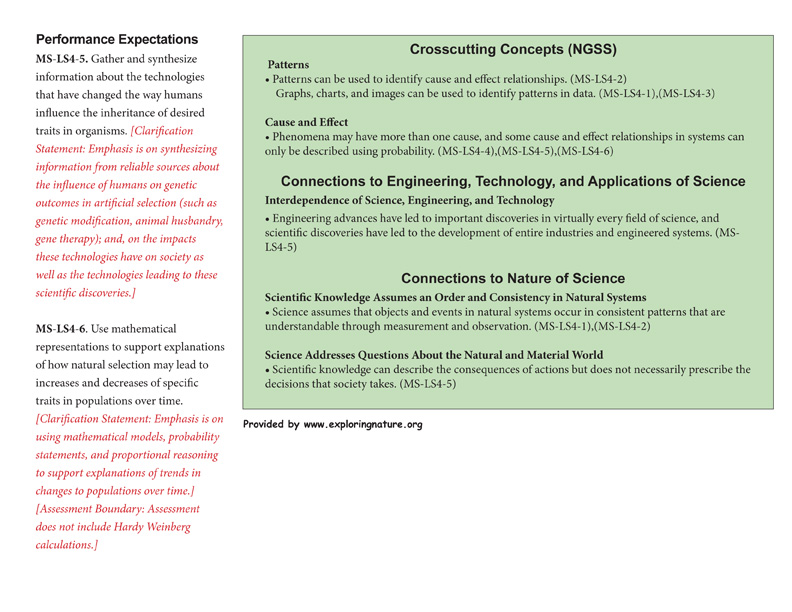

Disciplinary Core Ideas
LS4.A: Evidence of Common Ancestry and Diversity
• The collection of fossils and their placement in chronological order (e.g., through the location of the sedimentary layers in which they are found or through radioactive dating) is known as the fossil record. It documents the existence, diversity, extinction, and change of many life forms throughout the history of life on Earth. (MS-LS4-1)
• Anatomical similarities and differences between various organisms living today and between them and organisms in the fossil record, enable the reconstruction of evolutionary history and the inference of lines of evolutionary descent. (MS-LS4-2)
• Comparison of the embryological development of different species also reveals similarities that show relationships not evident in the fully-formed anatomy. (MS-LS4-3)
Use the Template and Resource Links to Fulfill NGSS
l. Goals:
Essential Questions:
NGSS Note: Think, question, entertain ideas.
ll. Introductory Activities to Assess Prior Knowledge
A. Brainstorming Sessions
Question: What do you know about fossils and the fossil record?
1. Break students down into groups of 3-4.
2. Ask students to generate a list of the different facts they know about the fossil record.
3. Discuss
lll. New Knowledge - Text
A. Research facts the about the fossil record.
V. Summarize Knowledge - Enduring Understandings
Vl. New Generation of Science Standards (NGSS) - Middle School Life Science
Disciplinary Core Ideas
LS4.A: Evidence of Common Ancestry and Diversity
• The collection of fossils and their placement in chronological order (e.g., through the location of the sedimentary layers in which they are found or through radioactive dating) is known as the fossil record. It documents the existence, diversity, extinction, and change of many life forms throughout the history of life on Earth. (MS-LS4-1)
• Anatomical similarities and differences between various organisms living today and between them and organisms in the fossil record, enable the reconstruction of evolutionary history and the inference of lines of evolutionary descent. (MS-LS4-2)
• Comparison of the embryological development of different species also reveals similarities that show relationships not evident in the fully-formed anatomy. (MS-LS4-3)
Science and Engineering Practices
Analyzing and Interpreting Data
Analyzing data in 6–8 builds on K–5 experiences and progresses to extending quantitative analysis to investigations, distinguishing between correlation and causation, and basic statistical techniques of data and error analysis.
• Analyze displays of data to identify linear and nonlinear relationships. (MS-LS4-3)
• Analyze and interpret data to determine similarities and differences in findings. (MS-LS4-1)
Using Mathematics and Computational Thinking
Mathematical and computational thinking in 6–8 builds on K–5 experiences and progresses to identifying patterns in large data sets and using mathematical concepts to support explanations and arguments.
• Use mathematical representations to support scientific conclusions and design solutions. (MS-LS4-6)
Constructing Explanations and Designing Solutions
Constructing explanations and designing solutions in 6–8 builds on K–5 experiences and progresses to include constructing explanations and designing solutions supported by multiple sources of evidence consistent with scientific ideas, principles, and theories.
• Apply scientific ideas to construct an explanation for real-world phenomena, examples, or events. (MS-LS4-2)
• Construct an explanation that includes qualitative or quantitative relationships between variables that describe phenomena. (MS-LS4-4)
Obtaining, Evaluating, and Communicating Information
Obtaining, evaluating, and communicating information in 6–8 builds on K–5 experiences and progresses to evaluating the merit and validity of ideas and methods.
• Gather, read, and synthesize information from multiple appropriate sources and assess the credibility, accuracy, and possible bias of each publication and methods used, and describe how they are supported or not supported by evidence. (MS-LS4-5)
When you research information you must cite the reference. Citing for websites is different from citing from books, magazines and periodicals. The style of citing shown here is from the MLA Style Citations (Modern Language Association).
When citing a WEBSITE the general format is as follows.
Author Last Name, First Name(s). "Title: Subtitle of Part of Web Page, if appropriate." Title: Subtitle: Section of Page if appropriate. Sponsoring/Publishing Agency, If Given. Additional significant descriptive information. Date of Electronic Publication or other Date, such as Last Updated. Day Month Year of access < URL >.
Amsel, Sheri. "LS4.A Evidence of Common Ancestry and Diversity (MS-LS4 Biological Evolution: Unity and Diversity)" Exploring Nature Educational Resource ©2005-2024. December 19, 2024
< http://exploringnature.org/db/view/LS4A-Evidence-of-Common-Ancestry-and-Diversity-MS-LS4-Biological-Evolution-Unity-and-Diversity >




